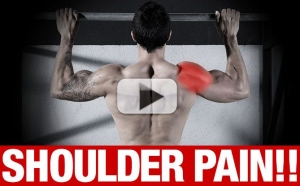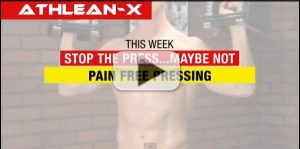

Perhaps the most common joint that is susceptible to these kind of extreme highs and lows is the shoulder. Why is that you ask? Well…by its very design, the shoulder is one of the most mobile but unstable joints in the body. That tradeoff of stability for mobility is like a reenactment of the Civil War with North battling South for control. The key to understanding whether or not to push it or give it a rest in these cases comes down to the following key points.
Question 1 – Does it hurt when you move it?
When answering the first question…what you’re looking for is to see whether you’re dealing with just instability or some kind of actual muscle tissue or joint problem. If you answered that you have pain….proceed to question 2. If you answered no to the first question….consult a PT about receiving an evaluation looking for potential hypermobility.
Question 2 – Does it hurt if someone else moves it for you?
The second question will reveal a lot, especially depending on how you answered the first question. Let’s say you answered yes to the first question….well, the second is going to tell you most likely if the problem is muscle related or joint related. If your shoulder hurts when you move your shoulder it can either be attributed to the muscles that are working being in distress during the movement….or the joint itself being compressed or strained in some way during the movement.
By removing the muscle contribution from the equation (by having someone else move the arm for you while you rest it) now you’re trying to rule out the joint surfaces as the sole cause of pain. If it hurts when your arm is moved by someone else then you’ve now confirmed that (with the muscles not involved) the joint surfaces are contributing to the pain and you might need to have an arthrogram or MRI to check for impingement issues, bone spurs, etc.
If it didn’t hurt when the arm was passively moved by someone else, you could comfortably look back to the muscles (rotator cuff, biceps tendon, etc) as the inflammatory suspect. In this case, the usual treatment is a few days away from the gym….or just avoiding the aggravating movement, ice after workouts and some anti-inflammatories.
Question 3 – Is it Weak and painful? Or Weak and Painless?
Finally…If the pain doesn’t seem to subside and significant weakness sets in…then you’ve got to ask yourself one final question. The first is…is there pain AND weakness or just weakness? If you’re looking at a potential rotator cuff tear the presence of pain would indicate a partial tear (due to the fibers that are still intact being asked to hold on for dear life pretty much) while the absence of pain would ironically usually indicate a complete tear (no pain nerve endings intact to elicit the pain).
So am I advising you to become your own doctor or physical therapist every time your shoulder aches? No.
But it does help to have a bit of an understanding of what you might want to be looking for as a potential cause, should your shoulder ever start to get in the way of effective training. Knowing how to troubleshoot the cause, while not curing the issue all the time, may at least help you to avoid doing something that will only hurt you more in the long run. And that folks, is where potential missed months of training become just missed workouts or exercises. More like tapping the brakes instead of slamming your foot on them on your road to new muscle growth.
Stay Strong,
Jeff
If you’re looking for the best workout program that not only doesn’t create or aggravate shoulder problems but in fact helps to prevent them (through it’s carefully selected exercises by former NY Mets physical therapist Jeff Cavaliere) then you should look into the AthLEAN-X Training System. 90 days to a better body. 90 days to a healthier body.

Jeff Cavaliere M.S.P.T, CSCS
Jeff Cavaliere is a Physical Therapist, Strength Coach and creator of the ATHLEAN-X Training Programs and ATHLEAN-Rx Supplements. He has a Masters in Physical Therapy (MSPT) and has worked as Head Physical Therapist for the New York Mets, as well as training many elite professional athletes in Major League Baseball, NFL, MMA and professional wrestling. His programs produce “next level” achievements in muscle size, strength and performance for professional athletes and anyone looking to build a muscular athletic physique.

































